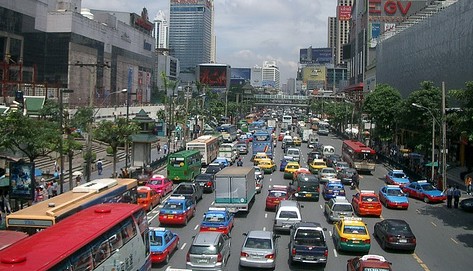Where on Earth Will All the Cars Go?
 Photo: Paul Trafford
Photo: Paul TraffordWhen wearing my Freakonomics hat, I see my job as giving you the reader the pecan pie of transportation, while shielding you from having to eat your vegetables. Much of this involves writing about research in the peer-reviewed journals, which typically 1) is unavailable to you since you don’t pay the subscription fees; 2) involves math which you’re lucky you don’t have to learn; 3) is on subjects like asphalt concrete rutting models or multivariate Poisson-lognormal random parameter models of intersection safety improvements, which I’m guessing are not lifelong passions of yours; and 4) often contains exciting ideas but goes about presenting them in prose that has been known to induce stupor and even coma.
However, none of my massaging is necessary with the articles in Access magazine. Access, which is produced by the University of California Transportation Center, is a terrific publication which presents state-of-the art, peer-reviewed transportation research in a format that is deliberately tailored for general readers; it’s well-written, pithy, devoid of technical jargon and advanced math, concise, and generally about transportation subjects that will be of universal interest.
And wait, there’s more. Access is free, including the entire archive. For a better deal than that, you’d have to find a transportation magazine that actually pays you to read it.
(Incidentally, I came to this blog thanks to an Access article I wrote on 19th century horse pollution, which Dubner and Levitt discovered while researching Superfreakonomics. When I wrote the piece many friends and colleagues for some reason doubted that manure mania would sweep America, but somehow it has turned into a minor meme. Jay Leno was just talking about the horse manure crisis on an episode of Nova).
Okay, okay, I’m not a totally disinterested party here. I just learned I’ll be taking over from Michael Manville as Associate Editor of Access in late summer, working under the direction of UCLA professor, editor, and parking rock-star Donald Shoup (more on his ideas coming soon). So much for my plug.
To get a taste of Access, check out this article from Mark Kutzbach, an economist at the Census Bureau, in the most recent issue. He discusses a topic of great interest which I haven’t written about yet: what is going to happen when those in poor nations start to buy cars at rich world levels? All the evidence indicates that as national wealth rises, auto ownership rises with it (though as Kutzbach points out, income distribution plays an important role too). If this is the case, what are the implications as rapidly-developing nations like China and India motorize?
It doesn’t take much in-depth statistical analysis to see that if developing nations adopt the auto at levels anywhere near those in the U.S., the implications in terms of fuel consumption and pollution (including greenhouse gasses, which will affect all of us) will be sobering.
Yet do we Americans have any right to weigh in on this issue? Yes, it’s in our naked self-interest to keep those in the developing world out of autos. But somehow it doesn’t seem like we have a tremendous amount of moral suasion here. Our cushy standard of living depends on the car; do we have any right to tell the Chinese to stick to the bicycle?
Kutzbach’s article does point a way out of this conundrum; as he notes, mass motorization isn’t going to work wonders for the developing countries themselves, as they are already wrestling with heinous traffic congestion problems.
We in the U.S. at least have the benefit (cost?) of infrastructure designed to handle large numbers of autos, but developing countries do not. Congestion in cities like Bangkok and Jakarta has already reached legendary levels, and as of 2002 Thai and Indonesian per capita vehicle ownership levels were only 15 percent and 4 percent respectively of those in the U.S. Those figures will only rise. So if they want to avoid a fate of perpetual gridlock, developing nations have a vested interest in addressing these issues even without our prodding.
But is it possible to tame automania? The obvious alternative is mass transit. Kutzbach demonstrates that buses may be slow, but (when full) they’re extremely efficient users of road space. Yet the mechanics of traffic circulation dictate that rising congestion disproportionately hurts the bus, which is one of the least maneuverable vehicles on the road and thus one of the worst at coping with bumper-to-bumper traffic. Falling bus speeds drive more people into cars, which exacerbates congestion problems, which further degrades bus service, fuelling a vicious circle.
Have any places avoided this trap? As Kutzbach lays out, a few have—notably Hong Kong and Singapore. How have they done it, and can other places follow their lead? Access Access to learn more. Coming up I’ll have more on motorization in the developing world. No vegetables, I promise.

Comments